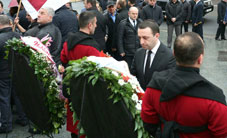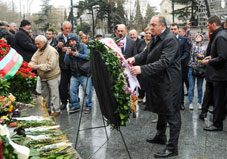
Georgia commemorates April 9 tragedy
By Gvantsa Gabekhadze
Friday, April 10
Georgian officials and ordinary citizens marked the 26th anniversary of April 9, a tragic day when peaceful Georgian demonstrators became victims of Russian troops.
The anti-Soviet movement became more active in the Georgian SSR in 1988, where several strikes and meetings were organized by anti-Soviet political organizations in Tbilisi.
The reason behind the strikes was the conflict between the Soviet government and Georgian nationalists.
The protest reached its culmination in April 1989.
Sixteen demonstrators were killed on Rustaveli Avenue and four others died later. Hundreds of activists were injured, poisoned and needed medical attention.
On April 9, 1991 Georgia gained independence from the Soviet Union.
“This day is a tragedy, indeed, but at the same time, April 9 is a symbolic day of the struggle for freedom and independence. These people really have shown us their miraculous self-sacrifice, heroism and have made an example of how to live, and how to sacrifice ourselves for our country. So, this is a victory of our nation,” Prime Minister Irakli Gharibashvili said.
“The blood of innocent patriots shed here in 1989 was reflected two years later in the Independence Act. Obviously, we all pay tribute to the people who were protecting our future state,” President Giorgi Margvelashvili said.
The opposition members also visited the April 9 memorial to pay tribute to the victims of the day. They stressed that Georgia still has to fight for its independence.
The appearance of the United National Movement members caused dissatisfaction among veterans however. One of the veterans, Malkhaz Chemia, demanded that the National Movement representatives leave the site, as they had no moral right to be near the April 9 memorial.
The veterans stated that the UNM used such dates and occasions for making political statements.


